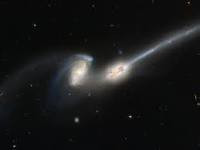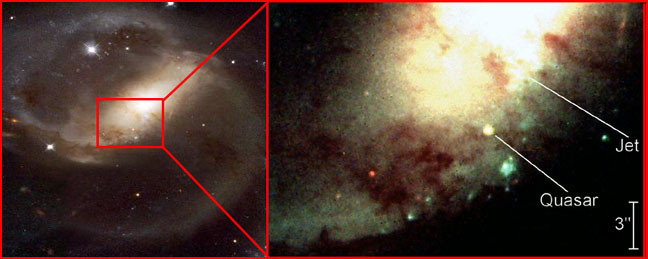Radio pulsar in an unstable orbit around something big?
I have a question. Ok, it’s more of a comment… Astronomers say a black hole is “almost” infinite density. Up until a couple years ago, they said a black hole WAS infinitely dense. This has me confused on several points.
First, almost infinite to me means damn near infinite. So, lets say one black hole is 90% close to infinite, and a second one is also 90%. It don’t take a mathmatician to see this don’t add up. According to this way of thinking, black holes are nowhere near infinite density, and in fact, would be tiny unmeasureable fractions of the total density of the universe.
Second, lets say the above is wrong, and black holes really are almost infintely dense. When I think of the term “density”, I am thinking matter and even energy. Maybe because in my mind, a higher density means more mass. I also realize mass also has to do with speed or accelleration, the faster something travels, the more mass it would have. For a black hole to have near infinite density, does that mean while it’s physical matter is not infinte by any stretch, maybe the sheer gravity is accellerating matter so much that it approaches infinite density? And wouldn’t the speed required for that be well beyond the speed of light?
Third, Lets say the above 2 things are all wrong and my thinking is screwed. Maybe the astronomers on all the tv shows that keep repeating the same things on every episode over and over are right, black holes are infinitely dense. Infinitely dense would include all matter in the universe. I am part of that matter. How can I be part of a black hole, and be outside of it pointing a telescope up at it at the same time?
Maybe someone out there with a phd and $600,000 in student debt can shed some light on this?
If I remember right (don’t take my word for it, I’m a pleb), the whole ‘infinitely dense’ thing comes from whether or not singularities are a point (similar to how an electrons, neutrinos, photons, etc… have no physical ‘size’) or occupy space.
We know that the have to be near-infinite density to produce the effects that they do, but we can’t directly observe a singularity to be able to tell. If the diameter is 0, the density would obviously be infinite, regardless of the mass. Either makes sense, as much as black holes make sense in the first place.
Knowing that black holes lose mass via hawking radiation, in my mind it makes sense for them to occupy space. Saying that, the existence of objects such as neutron stars points towards them having infinite density, unless there’s some other exclusion force which comes into play on such a small scale.
The density is equal to the mass divided by volume. So for an object to have infinite density either its mass is infinite (which you are assuming) or it doesn’t have any volume. The latter one applies to black holes.
This is also what appears to cause confusion in your first statement:
The numbers do add up, because we’re talking density and not mass 
Ok, I actually got schooled a bit, that was better than I thought. Thank you both for the replies, that went wayyy better than my ubuntu trial.
So an infinite density can simply be because the “mass” in a black hole doesn’t actually take up any space.
I have another question:) When we look out at say, the core of a galaxy, there are supermassive black holes, but then we can look around inside a galaxy and find smaller black holes. If the “stuff” that makes up a black hole has zero mass, why is one black hole bigger across than another?
My understanding of gravity is that material collects and forms bigger and bigger objects in space, until you have stars, neutron stars, and finally maybe black holes. I thought the only difference between a really big star and a black hole was we can see the light from one and not another. I know I am thinking small here, and I do understand that funny things happen the closer we are to even small objects like our sun because of gravity. But this type of understanding would lead me to believe that a black hole is still made of “something”.
I am willing to chalk up this possible misunderstanding to a lack of IQ on my part, but it really has me rethinking the reason I went to school. Other than reading and math, everything I learned in the 70’s and 80’s is turning out to have all been lies. And I studied hard and failed tests, and it was all for nothing. 9 years of school and a ged and I still can’t find my ass with both hands.
Black holes do have some mass, just not an infinite amount. They consist of the same matter all stars, planets and other objects are made of.
The more matter a black hole has accreted the stronger its gravitational attraction gets. Thus the radius from which no light can escape also grows which makes them visually appear bigger. All of the black hole’s mass is still concentrated in a single point though, so it does not actually take up more space.
What happens beyond event horizon stays beyond event horizon.
Sorry couldn’t resist.
What would happen if you went into a black hole is one of those questions that really Intrigues me.
I so get that 
I remember reading that galaxies would never ever collide but if the did they would pass through each other and no stars would collide because the distance between stars was so vast.
Made sense at the time.
Now we know even a near miss will tear galaxies apart, like the mice galaxies.

Quasars were the most disant objects with hug redshifts…but…
https://arxiv.org/abs/astro-ph/0409215
https://www.thunderbolts.info/tpod/2004/arch/041001quasar-galaxy.htm

Whoops!
My answer, enjoy the time we live in, never in history has the common man and woman had such access to such beauty and wounder from such amazing instruments. I grew up when the 200 inch on mt Palomar was the biggest and best telescope in the world and that was it. When New Horizons launched on it’s 17 year journey to Pluto I prayed to live long enough to see it. It was worth the wait 
This is where you get into relativity. Specifically, into Mass–energy equivalence, and mass and energy’s effect on spacetime.
Matter in stars is typical in that it follows our physical laws. Even in white dwarfs and neutron stars, which are held up by electron degeneracy pressure and neutron degeneracy pressure, respectively, the matter follows our physical laws, and the maths adds up. Neutron stars show us the limit of traditional matter’s density, before our laws break down.
Black holes do have an apparent mass.
This is where it gets a bit confusing. You have to say whether you’re talking about the density of the black hole as a whole, or just the singularity.
As we can’t directly observe black holes, we can calculate their mass based on their interactions with other objects, and their ‘density’ can be calculated using the mass and the Schwartzschild radius equation, which defines the radius of the event horizon using Einstein’s field equations. As black holes grow in mass, their density actually decreases. The average density of supermassive black holes is around that of water on Earth.
If we’re talking about the singularity specifically, this is where we say that they have near infinite or infinite density. The radius of the singularity has to be less than that of the event horizon, or , by its nature, it’s not a black hole. Because we can only hypothesize about the existence of singularities, we can’t say for definite what happens below the event horizon of black holes, and what happens to matter which is accreted, because matter and energy are equivalent. We can only say that any matter that is accreted contributes to the black hole’s apparent mass. Whether this ‘mass’ is a function of matter or energy is up for debate.
This is the bit where you shouldn’t pay too much attention because it’s me drawing conclusions, and I am in no way qualified to be making assertions like this.
If it was a function of material mass, a singularity couldn’t be a singularity, and would have a radius and a near-infinite density. This would abide by our laws of physics, but we would need to develop a new understanding of matter on such a scale.
If it was a function of energy, the singularity could exist with an infinite density and therefore an infinite gravitational field at its location in spacetime. In this case, our laws completely fall apart, and we’d need to develop/adapt new ways of understanding space, time, matter, energy, etc… (Saying this, particles such as light also doesn’t have mass or an apparent size, but their energy can be directly measured).
That’s not true. That was the knowledge of the time. You and nearly the rest of humanity didn’t know any better. It wasn’t even until the 80s that doctors were fully convinced of the correlation and causation of heart disease due to high blood pressure and that it should be treated, even though evidence of it goes back decades before. Most knowledge becomes out-dated at some point, and oftentimes, new knowledge is hard to accept. You’re being too hard on yourself.
It still makes sense. That’s what I heard too. Although there would be some stars flung out into intergalactic space during the collision, so I’m not sure of the severity of “tearing a galaxy apart” you had in mind. Not sure if this is always the result, but in the case of the Milky Way and Andromeda Galaxies (two spirals) coming together, the result is the birth of an elliptical galaxy (the Andromeda Way/Milky Andromeda).
So a singularity is a single point? I’m assuming by single point, what they mean is zero dimensions? Even my imagination is not able to quite cope with this. Maybe it’s like a ring of magnets that exert a pressure in the center of the ring, so there would be a definite pressure detected there, without anything actually being there? I have a gut feeling this is something difficult because we are limited by our sensory perceptions, and it’s hard to imagine something we’ve never seen or heard before.
I’m imagining it as star from which the things, including light, are being pulled to be the one and the same ice cold ball 
you have to understand that the immense gravity is now warping space/time, so within our limited classical knowledge of physics it is indeed considered a mathematical point.
Yeah, I get that somewhat. Gravity does weird things, even satellites have to have their clocks synched to account for a difference gravity creates in time, I could imagine what something with crazier gravity can do.
I can do math pretty well, just not the large equation shit. Math has always seemed kinda strange to me too. Take addition, for example. If I add 1+1, the standard answer is 2. But If I truly, in reality, add one thing to another, it is still only one. For example, if I wad up 2 sheets of paper together, it it one ball of paper.
Mathematics is a great way to make things work, but it can never be a real model for reality. I use alot of radio math, and it gets me close, but some tweaking always has to be done. I know the argument could be made about all the unknown variables, and if the math took them into account, it would be perfect, but I think the variables are more infinite than the density of a black hole:)
that’s a strange way of seeing things, i can say the one wad of paper is composed of two sheets of paper. still 2. that’s more about the semantics of human language, particularly English.
I may have missed it, did anyone post this video they made of the falcon heavy?
That tight landing still looks so damn cool, they just did do it suddenly like the earlier landings slowly came down with lots of burn, and then one stream just did do that freefall and tight burn, done, happy ending
link

